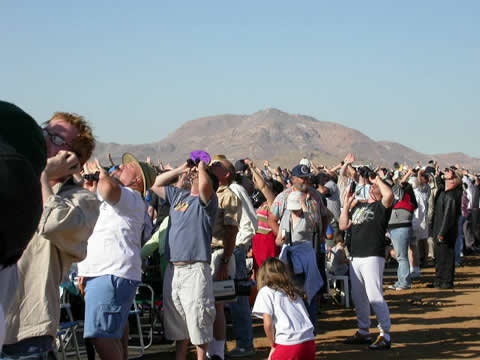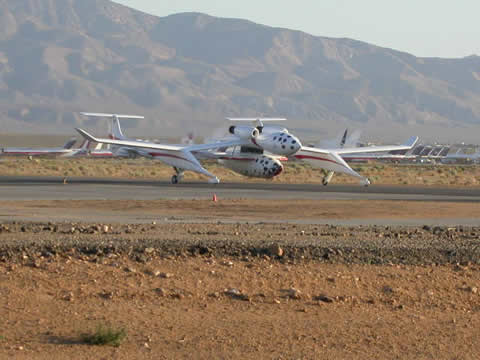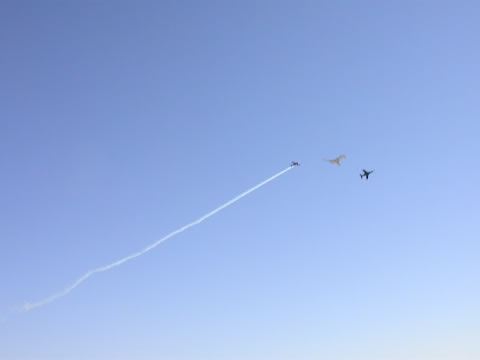Search this Site







Go, Burt, Go!
By Robert Gounley
My wife, Paula, had been concerned about me since beginning our journey to the Mojave Airport at 2:00 in the morning. I'd had only a few hours sleep and my driving was not at its sharpest. Paula and our passenger, Diane Rhodes, had slept most of the way over and I wanted to do the same. Somehow we arrived safely at a makeshift parking lot were thousands gathered to view the launch of SpaceShip One. The blue lights marked a tarmac leading to a fence set up on the runway. It was now nearly dawn and we were all staking out good spots to watch the historic event. We needn't have worried. The sky was turning a clear blue and the most of the show would take place above our heads.
 |
| Crowds watching X Prize-winning flight. Photo courtesy Robert Gounley. |
The crowd was an odd mix: die-hard spacers with their pick-up trucks and curiosity-seekers with their RVs. Amateur astronomers unpacked expensive telescopes for unaccustomed daylight viewing. Next to them, young children pulled throwaway cameras from their pockets.
At the appointed time, a procession of three aircraft, and one aircraft/spacecraft, began taxiing down the runway. Three chase planes would escort SpaceShip One and its mother ship, White Knight, to launching altitude.
Most of the planes would look right at home at a neighborhood airshow. What made it different were the stars of this event-a spindly looking jet plane carrying the stubby-winged rocket plane. A large nozzle protruded from the back of SpaceShip One. Glinting in the morning light, a dozen or more round windows could be seen around the cockpit. They were clearly made for paying passengers.
 |
| The White Knight taxing with SpaceShipOne. Photo courtesy Robert Gounley. |
One by one, the planes took off. They made one broad circle around the airport, and then another. Dozens more loops followed. Folks contorted to keep watch on the ascending aircraft. They grew less visible with every loop. Whenever the formation appeared in the east, eyes squinted from the sunlight.
One by one, each chase plane dropped out of formation, unable to fly higher. Reaching the launch altitude took White Knight/
SpaceShip One over an hour. They were now faint white specks against the morning sky.
Launch approached and we looked for the contrail to tell us where White Knight was. They lead right beside the sun. Thousands of arms rose in salute to block the light.
The speakers counted down seconds. At "zero", a smoke trail drew a white line quickly across the sky. SpaceShip One was climbing fast. Onboard the pilot must have been admiring the transition of blue sky to black-provided he wasn't completely absorbed in the business of controlling a small plane riding on more thrust than all the engines of a jumbo jet. The tarmac rumbled with whoops and cheers. The crowds greeting Lindbergh at Orly airfield could not have been any more enthusiastic.
 |
| Chase planes during the flight. Photo courtesy Robert Gounley. |
High above, the smoke trail ended. The rocket-plane should now be coasting to peak altitude. The loudspeakers gave the news we'd all wanted to hear. SpaceShip One had reached over 100 km altitude-an internationally accepted definition for crossing the boundary into space. The pilot and his plane were well. They'd be landing shortly.
The ride home was as about as unsteady as the ride out. Instead of feeling fatigue, I was buzzing with excitement. From a tiny commercial airport in the middle of the desert, we'd all watched a man fly into space. What was once only a theoretical possibility had become an observed fact. There's still much to do before paying passengers become a regular occurrence, but that time was looking a whole lot closer this day.
I thought about the thousands of spectators driving and flying back to their homes. They'd all be asking themselves the same question.
When's my turn?
Copyright © 1998-2005 Organization for the Advancement of Space Industrialization and Settlement. All Rights Reserved.